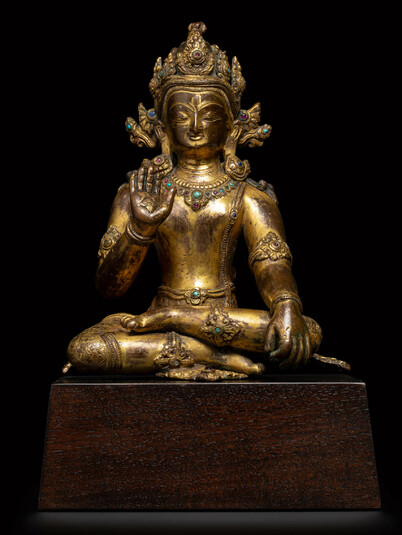
Item: Manjushri (Bodhisattva & Buddhist Deity) - Bodhisattva
| Origin Location | Nepal |
|---|---|
| Date Range | 1400 - 1499 |
| Lineages | Buddhist |
| Material | Metal, Mercuric Gild |
| Collection | Private |
Classification: Deity
Appearance: Peaceful
Gender: Male
Bodhisattva: although currently unidentified, it is very possible that the figure belongs to a set of the Eight Great Bodhisattvas.
Bodhisattva (Tibetan: jang chub sem pa. English: heroic aspirant to enlightenment): there are three very different meanings of the term bodhisattva depending on context. The first [1] is a descriptive art meaning. The second [2] is a category of deity within Buddhist art and iconography. The third [3] is the abstract religious definition of a bodhisattva as a level of achievement along the Buddhist path.
Peaceful in appearance with one face and two hands, the right raised and the left extended across the knee, seated with the two legs placed in a relaxed posture. Lacking a recognizable attribute this figure can not be identified with any certainty. It is not Lokeshvara who would typically have a small figure of Amitabha Buddha on the crown and deerskin draped over the left shoulder. The upraised and forward hand gestures are not typical for other popular bodhisattva figures such as Manjushri, Vajrapani and Maitreya.
Depictions of the Eight Great Bodhisattvas have been a common theme in art for the past millennium especially with Khasa Malla and Kathmandu based Nepalese works. The four most common bodhisattvas from this group, Manjushri, Lokeshvara, Vajrapani and Maitreya, are typically decorated with their attributes such as a sword, white lotus, vajra scepter or a wheel. The four remaining lesser known bodhisattvas, Samantabhadra, Kshitigarbha, Akashagarbha and Nivarana-vishkhambhin, are often difficult to recognize because of a lack of attributes, a lack of attribute and iconographic standardization, or simply not knowing or recognizing the attribute.
It is not likely a sambhogakaya buddha such as Amoghasiddhi because the leg positions are not appropriate based on textual descriptions and comparable artistic examples. A distinguishing feature between sambhogakaya buddhas and bodhisattva figures are the leg postures. Buddhas have the two legs crossed in vajra posture. Bodhisattvas, when representing figures from Mahayana Buddhist literature, have the legs placed in a relaxed posture, loosely placed, a knee upraised, or legs pendant.
Vajra Posture (asana) is a Buddhist term referring to a seated position where the feet are placed sole up on the thigh of the opposite leg; right over left. In modern times this posture is almost universally referred to as the lotus posture because of the popularity of Hatha Yoga and terminology used in the major Hindu traditions - subjects generally more familiar to a Western audience. The location of the Buddha's enlightenment in India, now called Bodhgaya, is historically called Vajrasana in Buddhist literature. The posture in which the Buddha sat while reaching enlightenment is known as the vajra posture. The highest, deepest, level of meditation (samadhi) that is accomplished immediately prior to, and on reaching full enlightenment, Buddhahood (in this vajra location and seated in vajra posture) is vajra samadhi. (See Postures in Iconography).
Jeff Watt 8-2020
Buddhist Deity: Manjushri & Maitreya Differences
Collection: Kapoor Galleries (Masterworks)
Buddhist Figure: Bodhisattva Main Page
Collection: Kapoor Galleries

